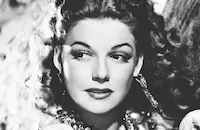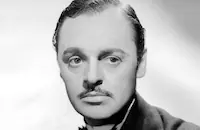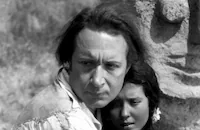The Unfaithful

Brief Synopsis
Cast & Crew
Vincent Sherman
Ann Sheridan
Lew Ayres
Zachary Scott
Eve Arden
Jerome Cowan
Film Details
Technical Specs

Synopsis
Chris Hunter returns from a party one night while her husband Bob is out of town, and is accosted by Michael Tanner. During the ensuing struggle, Chris kills Tanner. Bob, a builder who has been away on business, arrives home the following morning to discover his house surrounded by police. Later, Chris tells homicide detective Reynolds that Tanner, whom she did not know, demanded her jewelry, and she stabbed him in self-defense. While Chris, Bob and their lawyer, Larry Hannaford, have lunch, Larry receives a telephone call from his office regarding Chris. The call leads him to a shabby art dealer's shop, where the dealer, Martin Barrow, shows him a bust of Chris sculpted by Tanner. He offers to sell it to Chris for $10,000. Larry angrily turns down the offer and then confronts Chris. At first Chris denies everything, but later admits that she met Tanner while Bob was overseas during the war. She allowed him to sculpt the bust, but ended the relationship when Tanner tried to make it more personal. Tanner then continued to harass her. Chris tells Larry that she did not reveal the truth to the police because she was afraid that the scandal would hurt Bob's business. Larry advises Chris to tell Bob and Reynolds the truth, but instead she tries to buy the sculpture from Barrow. Barrow, however, has given the sculpture to Tanner's wife. When Larry learns what Chris has done, he realizes that she had an affair with Tanner. Chris admits it, but insists that Tanner was trying to kill her the night of the murder and begs Larry to help her buy back the sculpture. Determined to make Chris suffer as she has, Tanner's wife shows the sculpture to Bob, who is deeply wounded. Later, Mrs. Tanner goes to the police and implicates Chris. Bob then confronts Chris, who admits that his accusations are true. She explains that they had only known each other two weeks before he left for the war and because she was lonely, she became involved with Tanner. Bob is unmoved by her defense and asks for a divorce. Moments later, Chris is arrested for murder. After a scandalous trial, Chris is acquitted, due in part of Larry's impassioned defense, but Bob still refuses to forgive her. Larry encourages the couple to talk to each other and try to make a go of their marriage and, when they agree, leaves them alone to reconcile.

Director

Vincent Sherman
Cast

Ann Sheridan

Lew Ayres

Zachary Scott

Eve Arden

Jerome Cowan

Steven Geray

John Hoyt
Peggy Knudson
Marta Mitrovich

Douglas Kennedy
Claire Meade
Frances Morris
Jane Hacker
Joan Winfield
Jay Eaton
Tristram Coffin

Jack Mower
Jean Debriac
Lois Austin
Ross Ford
Eve Whitney
Mary Field
Dorothy Christy
Ray Montgomery

Monte Blue
Paul Bradley
Richard Walsh
John Elliott
Maude Fealy
Carey Harrison
Betty Hill
Bob Lowell
Charles Marsh
Charles Jordan
John Vosper
George Hickman
Bob Alden
Crew
Robert Burks
Alan Crosland Jr.
Murray Cutter
Leo F. Forbstein
David Goodis
James Gunn
Ernest Haller
Felix Jacoves
Leo K. Kuter
William Mcgann
James Mcmahon
Francis J. Scheid
Max Steiner
Travilla
Jerry Wald
William Wallace
Jack L. Warner
Perc Westmore

Videos
Movie Clip




Trailer
Film Details
Technical Specs

Articles
The Unfaithful
Better parts followed, in They Drive by Night (1940) with George Raft and Humphrey Bogart, in The Man Who Came to Dinner (1942) with Bette Davis and Monty Woolly and in Kings Row (1942) with Robert Cummings and Ronald Reagan. Although Sheridan had worked hard to lose her syrupy North Texas accent, she retained her salty sense of humor, likening the word "oomph" to "a fat man bending down to tie his shoelaces."
Once she had some cachet with the studio, the actress developed a reputation for turning down parts, including lead roles in Raoul Walsh's The Strawberry Blonde (1941), which went to Rita Hayworth, and in Michael Curtiz' Mildred Pierce (1945), which netted an Academy Award for Joan Crawford. During World War II, Sheridan traveled to India to entertain US troops. (A B-26 bomber was christened "The Sheridan Express" and its fuselage bore her likeness.) The actress spent eighteen months on suspension at Warners, fighting for a pay raise, and eventually walked away with a six picture deal and script approval.
Sheridan would eventually buy herself out of her Warners contract but not before appearing in a handful of final films, among them the quasi-film noirs Nora Prentiss and The Unfaithful, both released in 1947 and both directed by Vincent Sherman as vehicles produced specifically as showcases for "the Oomph Girl."
Sherman had used his own money for the option on Paul Webster's unpublished story "The Man Who Died Twice"; at the behest of studio head Jack Warner, the story's female protagonist was made more prominent and the project renamed Nora Prentiss, with Sheridan in the title role. That film's success demanded a follow-up. Sherman and producer Jerry Wald had originally wanted to adapt James M. Cain's 1937 novel Serenade for Sheridan and Dennis O'Keefe but the book's homosexual subplot queered the deal. Sherman's counter offer to Warners was James Gunn's unfinished screenplay, The Unfaithful, an unofficial remake of William Wyler's The Letter (1940). Despite reservations from the front office about green-lighting an incomplete shooting script, Sherman pressed ahead with a start date two weeks off. Ann Sheridan was secured for the lead, Zachary Scott and Lew Ayres were cast as her costars and Eve Arden scored the second female lead. Sherman offered his cast a scene breakdown and twenty pages to start and all agreed to the unusual situation in a show of faith in their director. Upon viewing a rough cut of the film, Warner proclaimed to Sherman "Any sonofabitch who can make a picture like I saw last night, without a script, can stay here (at Warner Brothers) as long as he likes."
In her 1985 memoirs Three Faces of Eve, Eve Arden discussed her participation in the rushed and at times unpredictable production, which was the subject of much curiosity, gossip and anxiety on the Warners lot throughout principal photography:
"There was nothing for any of us to do but call on a sense of humor. This we did, to the point where one day we were unable to look each other in the eye without laughing. It became painful both to us and the director, but there was no help. If I gained enough control to read a line, Annie's lip would begin to quiver and her eyelashes would bat. Then Zach's voice would break and the director would yell "Cut!" As we struggled for composure, someone made the mistake of threatening to call Jack Warner down to the set. That did it. Tears of laughter ruined three make-ups and we took a break to recover and repair. Only the fact that we were three of the studio's most professional actors saved our combined necks."
Despite the fears of cast and crew, The Unfaithful proved to be another success (if not the Oscar® magnet that The Letter had been), allowing Vincent Sherman to broker a substantial pay hike for himself and an improved, five year contract. After leaving Warners, Ann Sheridan won a plumb leading lady assignment opposite Cary Grant in Howard Hawks' classic screwball comedy I Was a Male War Bride (1949), which was a career high point but also marked the beginning of the end of her arc as a Hollywood star.
Through the 1950s, Sheridan worked as often in television as in features, with guest spots on Playhouse 90, Pursuit, Wagon Train and the daytime drama Another World. A heavy smoker, Sheridan had been diagnosed with esophageal and liver cancer when she accepted a leading role on the CBS-TV sitcom Pistols 'n' Petticoats in 1966. She completed 21 out of 26 episodes before her death on January 21, 1967, at the age of 51. "I always felt that Ann was not driven to become a big movie star," Vincent Sherman wrote of Sheridan in his 1996 memoirs. "For a short while she enjoyed the advantages of being in the limelight... but I always felt that she would have preferred being a housewife with a loving husband and children. She was a grand girl, talented, and a joy to know and work with."
Producer: Jerry Wald
Director: Vincent Sherman
Screenplay: David Goodis, James Gunn; W. Somerset Maugham (novel, uncredited)
Cinematography: Ernest Haller
Art Direction: Leo K. Kuter
Music: Max Steiner
Film Editing: Alan Crosland, Jr.
Cast: Ann Sheridan (Chris Hunter), Lew Ayres (Larry Hannaford), Zachary Scott (Bob Hunter), Eve Arden (Paula), Jerome Cowan (Prosecuting Attorney), Steven Geray (Martin Barrow), John Hoyt (Det. Lt. Reynolds), Peggy Knudsen (Claire), Marta Mitrovich (Mrs. Tanner), Douglas Kennedy (Roger), Claire Meade (Martha), Frances Morris (Agnes), Jane Harker (Joan).
BW-109m.
by Richard Harland Smith
Sources:
Ann Sheridan interview, People Will Talk by John Kobal (Knopf, 1986)
Ann Sheridan: A Bio-Bibliography by Margie Schultz (Greenwood Publishing Group, 1997)
Studio Affairs: My Life as a Film Director by Vincent Sherman (University Press of Kentucky, 1996)
Three Faces of Eve by Eve Arden (St. Martin's Press, 1985)

The Unfaithful
Quotes
Trivia
Notes
According to a November 25, 1946 Hollywood Reporter news item, the film treatment met with the approval of the MPAA in late Nov. On January 24, 1947, Los Angeles Daily News reported that although Ann Sheridan plays an adultress who is not punished, as the Production Code demands, the MPAA agreed to allow this if the film clearly conveyed the message that divorce is undesirable. A November 7, 1946 Hollywood Reporter news item noted that the film's starting date was postponed because of a studio strike. The film contains shots of Angel's Flight and MacArthur Park in Los Angeles. The house in which "Chris Hunter" and her husband "Bob," live is located in Beverly Hills. Although David Goodis and James Gunn are credited onscreen with creating an original screenplay, several reviewers noted the story's similarity to the 1940 Warner Bros. film The Letter (see AFI Catalog of Feature Films, 1931-40; F3.2470) written by Howard Koch and starring Bette Davis, and some modern sources consider this film a remake of The Letter.















